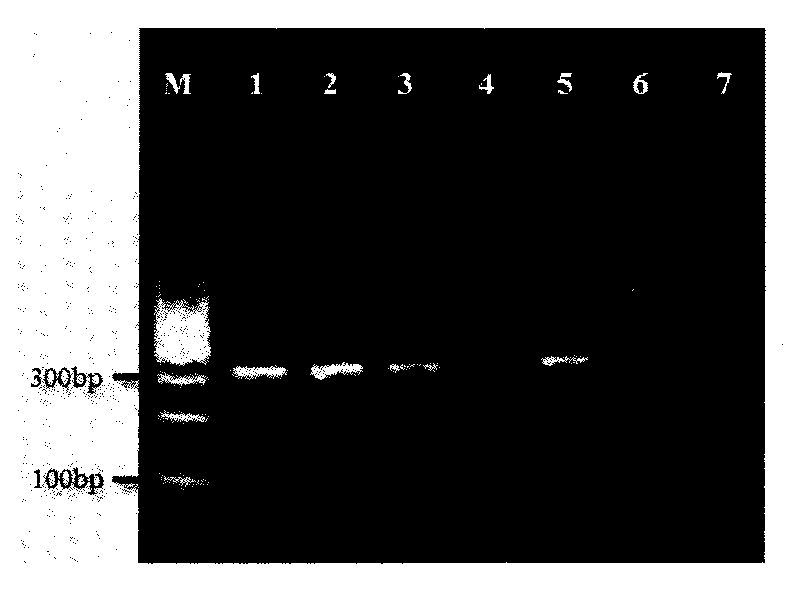Method for extracting DNA from single eggs of copepods
An extraction method and technology for copepods, which are applied in the field of DNA extraction and can solve the problems of damage, straight elution efficiency, and no work report on genome DNA extraction from a single egg of copepods.
- Summary
- Abstract
- Description
- Claims
- Application Information
AI Technical Summary
Problems solved by technology
Method used
Image
Examples
Embodiment 1
[0017] Place a single copepod egg in 5-10 μL of 1×TE buffer solution (pH 8); add proteinase K to make the final concentration of proteinase K reach 4 mg / mL (the purpose of adding proteinase K is mainly through the action of proteinase K to destroy the external structure of the egg so that the internal DNA can be released smoothly, and at the same time avoid the loss of DNA caused by physical damage); after adding proteinase K, a mixed extract can be obtained, and the mixed extract obtained will be passed through A heat incubation program, the specific program is as follows: place at 55°C for 30 minutes, then place at 95°C for 5 minutes. After the above procedures are completed, the crude extract of single egg DNA can be obtained, and then precipitated by the nucleic acid co-precipitation agent (DNA Mate) produced by Takara Biotechnology Co., Ltd. (Takara). The specific steps of precipitation are as follows: Add 1 / 10 volume of 3M sodium acetate solution and 4 μL DNA Mate to the...
Embodiment 2
[0020]Similar to Example 1, a single copepod egg was placed in 5-10 μL of 1×TE buffer (pH 7.5); proteinase K was added to make the final concentration of proteinase K reach 2.5 mg / mL (the purpose of adding proteinase K Mainly through the action of proteinase K to destroy the external structure of the egg so that the internal DNA can be released smoothly, and at the same time avoid the loss of DNA caused by physical damage); after adding proteinase K, a mixed extract can be obtained, and then The obtained mixed extract was subjected to a heat incubation procedure, and the specific procedure was as follows: standing at 60° C. for 25 minutes, and then standing at 95° C. for 5 minutes. After the above procedures are completed, the crude extract of single egg DNA can be obtained, and then precipitated by the nucleic acid co-precipitation agent (DNA Mate) produced by Takara Biotechnology Co., Ltd. (Takara). The specific steps of precipitation are as follows: Add 1 / 10 volume of 3M so...
Embodiment 3
[0022] Similar to Example 1, a single egg of the copepod was placed in 5-10 μL of 1×TE buffer (pH 8.5); proteinase K was added to make the final concentration of proteinase K reach 5.5 mg / mL (the purpose of adding proteinase K Mainly through the action of proteinase K to destroy the external structure of the egg so that the internal DNA can be released smoothly, and at the same time avoid the loss of DNA caused by physical damage); after adding proteinase K, a mixed extract can be obtained, and then The obtained mixed extract was subjected to a heat incubation procedure, the specific procedure was as follows: 120 minutes at 37°C, and then 5 minutes at 95°C. After the above procedures are completed, the crude extract of single egg DNA can be obtained, and then precipitated by the nucleic acid co-precipitation agent (DNA Mate) produced by Takara Biotechnology Co., Ltd. (Takara). The specific steps of precipitation are as follows: Add 1 / 10 volume of 3M sodium acetate solution and...
PUM
 Login to View More
Login to View More Abstract
Description
Claims
Application Information
 Login to View More
Login to View More - R&D
- Intellectual Property
- Life Sciences
- Materials
- Tech Scout
- Unparalleled Data Quality
- Higher Quality Content
- 60% Fewer Hallucinations
Browse by: Latest US Patents, China's latest patents, Technical Efficacy Thesaurus, Application Domain, Technology Topic, Popular Technical Reports.
© 2025 PatSnap. All rights reserved.Legal|Privacy policy|Modern Slavery Act Transparency Statement|Sitemap|About US| Contact US: help@patsnap.com

